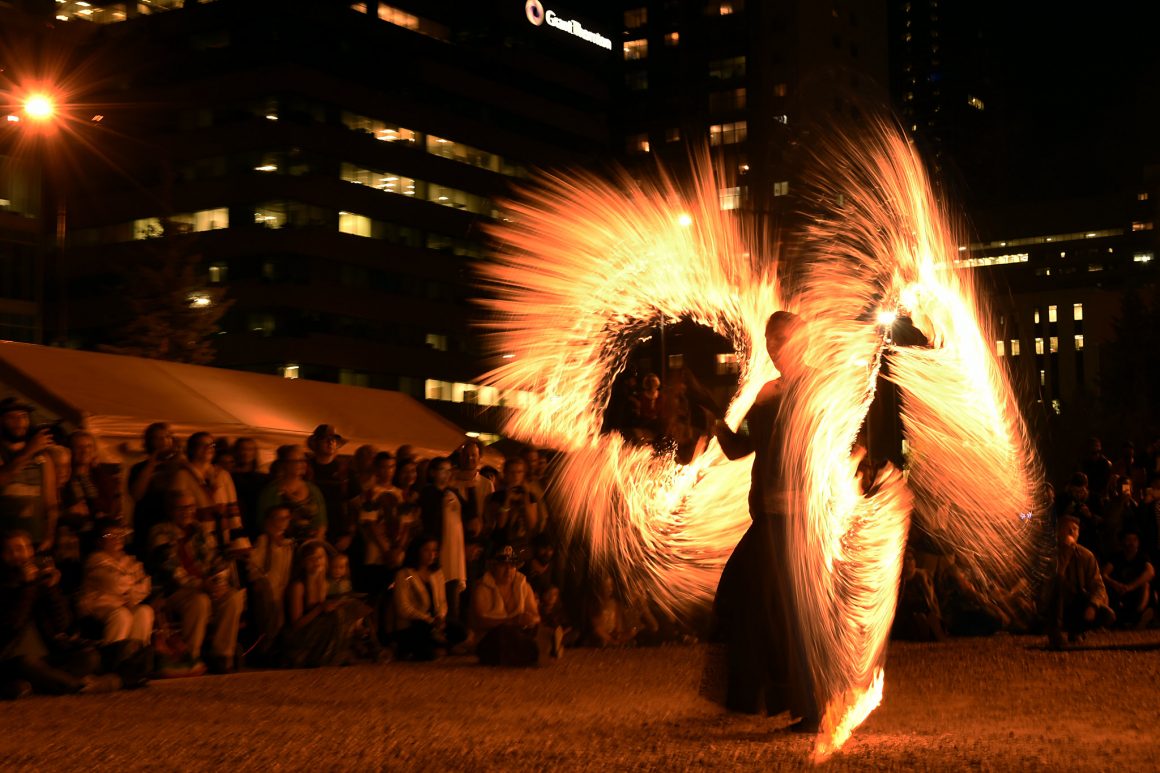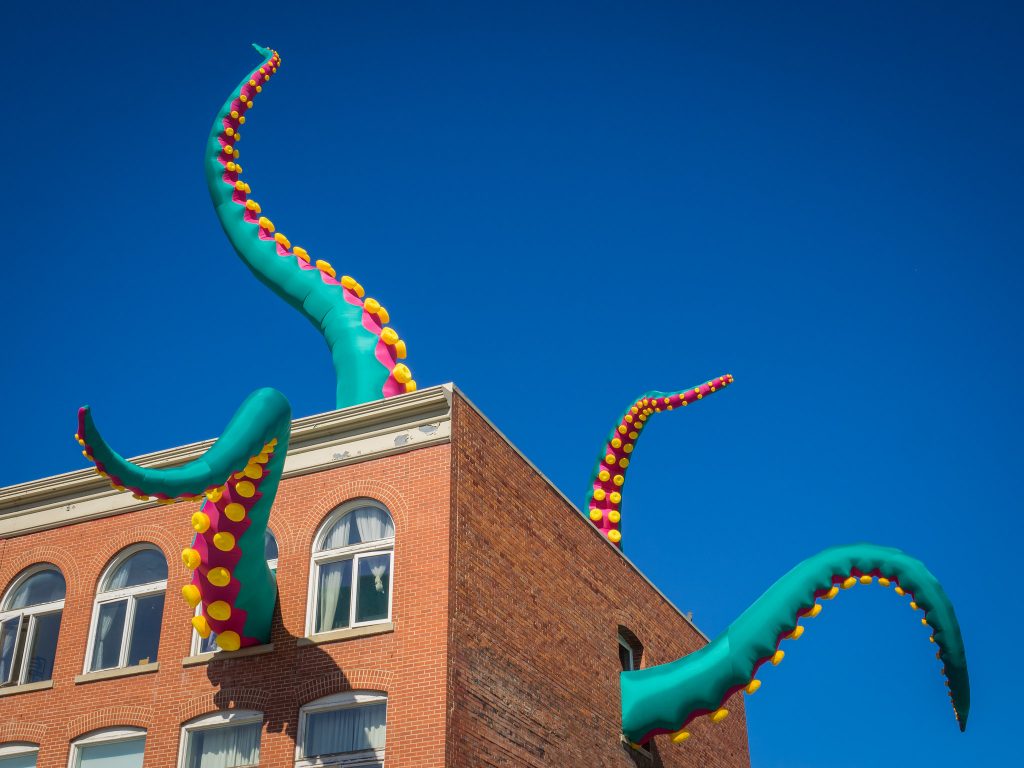
Beakerhead brings science and art to centre stage
By Troy Hasselman, September 11 2019 —
Beakerhead, Calgary’s annual festival that exists on the intersection of arts, science and technology is set to return with showcases of exhibits across the city that are equal parts innovative and confounding.
The origins of Beakerhead stretch back to 2008 when Beakerhead co-founder Jay Ingram — also known for his time hosting CBC’s Quirks and Quarks and Discovery’s Daily Planet — and his partner, new Telus SPARK CEO Mary Anne Moser, were running a science communications program at the Banff Centre. Ingram credits Moser with the concept for Beakerhead.
“She thought a science event in the streets of Calgary that combined art, science and engineering would have some appeal,” Ingram says. “I get credit for being the co-founder because she said ‘Do you think that’s a good idea?’ And I said ‘Yeah.’ Then it came to name it and she had two ideas for a name. Beakerhead was one — I don’t know where that came from — and the other was going to be Robertson after the Canadian-invented screwdriver and actually Robertson isn’t a bad name but she said ‘Which one do you like?’ and I said ‘Beakerhead.’ So that cemented my status as co-founder and that was it.”
Beakerhead has steadily grown in popularity and attendance since its inaugural run in 2013. As Ingram noted, this hasn’t been without the difficulties of establishing a new festival and dealing with the always-unpredictable Calgary weather.
“In our first year we got tremendous crowd reaction — people loved it,” Ingram says. “We had a three-piece robot, heavy-metal band. Chris Hadfield was at Arts Commons with a band that I play with and we had fantastic people that night. At the same time, if you went around the streets of Calgary after and asked people ‘Have you ever heard of Beakerhead?’ 19/20 people would say ‘No, what is it?’ There’s no such thing as an overnight sensation, it felt like it but we had to build audience awareness and confidence ever since. We get plagued by bad weather sometimes. The 2014 snowstorm wiped out the first day completely. Last year, Beakernight on Saturday night at Fort Calgary, the weather was horrid. But people love it, there is something about it that sets it apart from the science center or arts offerings. It works somewhere in between.”

Photo courtesy Trevor Lalonde
In past years, Beakerhead has received a large portion of its exhibitions from outside sources like the Burning Man Festival which happens the first week of September in Nevada. In recent years, however, the festival has been focusing on showcasing local talent and the festival this year has an exceptionally high proportion of local talent.
“We don’t want to keep importing art installations from elsewhere,” Ingram says. “We want them to be imagined, constructed and designed here in Calgary, if not somewhere in Alberta, and if not Canada. We’ve brought stuff from Australia, Europe, everywhere but we really want to create a local group of people to do this. I’d say out of the installations on Prince’s Island Park this year, probably four or five are from outside but most of the rest are from here.”
For this year’s edition, the festival will culminate in “The Spectacle” on Sept. 21 in Prince’s Island Park, moving the venue from its previous location at Fort Calgary. Ingram says this change of location offers a more close-together space to hold the event.
“This year, the decision was made to focus more tightly,” Ingram says. “Both in terms of numbers of events or installation but also because we’re selling tickets now. We sold tickets at Fort Calgary last year and it’s very difficult at such a vast area. Prince’s island is much more focused, if you price the tickets reasonably you can give people a fantastic experience because it’s going to be a lot of Beakerhead stuff in very close quarters with propane everywhere. So I’m confident it’s going to be great. It’s really more of a logistical thing, if we’re going to ask people to pay money we have to make sure it’s not too far-flung and it’s something they’ll have a great experience with.”
Some highlights from this year’s festival will include work done by local artist Paul Magnuson, who has been previously involved with the festival, and a piece that will have its first display here after technical difficulties prevented a previous exhibition at Burning Man.
“There is a local guy named Paul Magnuson and he’s designed something called The Cube which responds to movement and colour and will react in terms of sound and colour,” Ingram says. “We love two things, we love interactive, but we also love putting two things together that you don’t ever expect to be together. There’s another one called Paraluna by Christopher Schardt, whose called the Godfather of LED’s. It was at Burning Man but it broke down so it’s never been fully shown. It’s got 17,000 LED’s — it looms over you.”

Photo courtesy Denise Kitagawa
“There is, of course, a fire-breathing dragon as there has to be,” Ingram laughs.
Ingram hopes for the festival to continue and be able to grow and join the Stampede as one of the star attractions that people associate our city with.
“I think a city like Calgary that scores incredibly high on liveability, there was that survey that came out recently that places us in fifth in the world or something crazy like that,” Ingram says. “I think we should be represented by a more significant event as well as a rodeo, let’s have something that reflects tech and the artistic community.”
Beakerhead acts as a festival but as well as a means of interesting people in science, and especially getting kids interested in science.
“I know about the community of people that care about science in this country pretty well,” Ingram says. “For many of them, you’ve got to talk hard science, you’ve got to get people understanding just what’s at the frontiers at science and quite often that’s not the right place to start. You can go to quite a few Beakerhead installations and walk away and not really have learned any science. But we think that experience you’ve had is one of delight. ‘Oh wow, I’ve seen that. That’s incredible.’ Not only that but we want kids to think ‘You know, maybe I can do that.’
Ingram notes that the link between art and science is one of the things that makes the festival so unique, and the emotional reactions that the festival can give are important to spreading the appreciation of science.
“When I started my career I was keen to give people all the science they could possibly handle and I’ve become really much more interested in making it entertaining, pulling at your emotions,” Ingram says. “Honestly, if you don’t communicate a message that has emotion in it, you might as well forget it. I was at a writers event in Ottawa and Guy Vanderhaeghe, the great short story writer, said ‘You know, if I want to communicate information I’ll write an essay. If I want to communicate emotion I’ll write a short story.’ He’s right, emotion has to be a part of it. If you come up and there’s an amazing 35-foot bear that can give you an emotional reaction and if you want to find out more about how those things can be built you can do that.
Beakerhead runs from Sept. 18–22 with exhibitions, workshops and shows taking place over the four days. Tickets range between free and $70 for events in the festival, with tickets to The Spectacle costing $27.50 for adults, $22.50 for youth and free for children 12 and under. For more information about the festival, the lineup and tickets visit beakerhead.com.

Photo courtesy Denise Kitagawa
